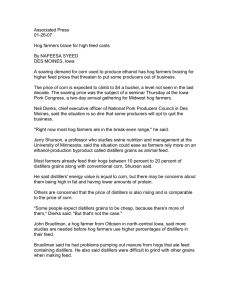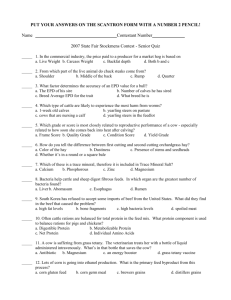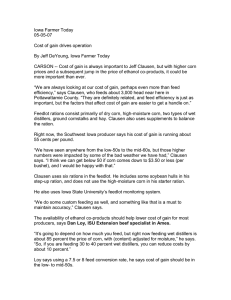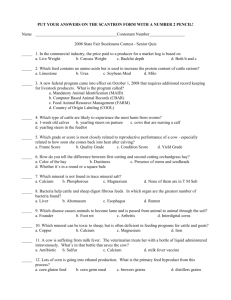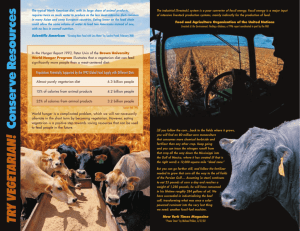Bismarck Farm & Ranch Guide, USA 12-07-06
advertisement
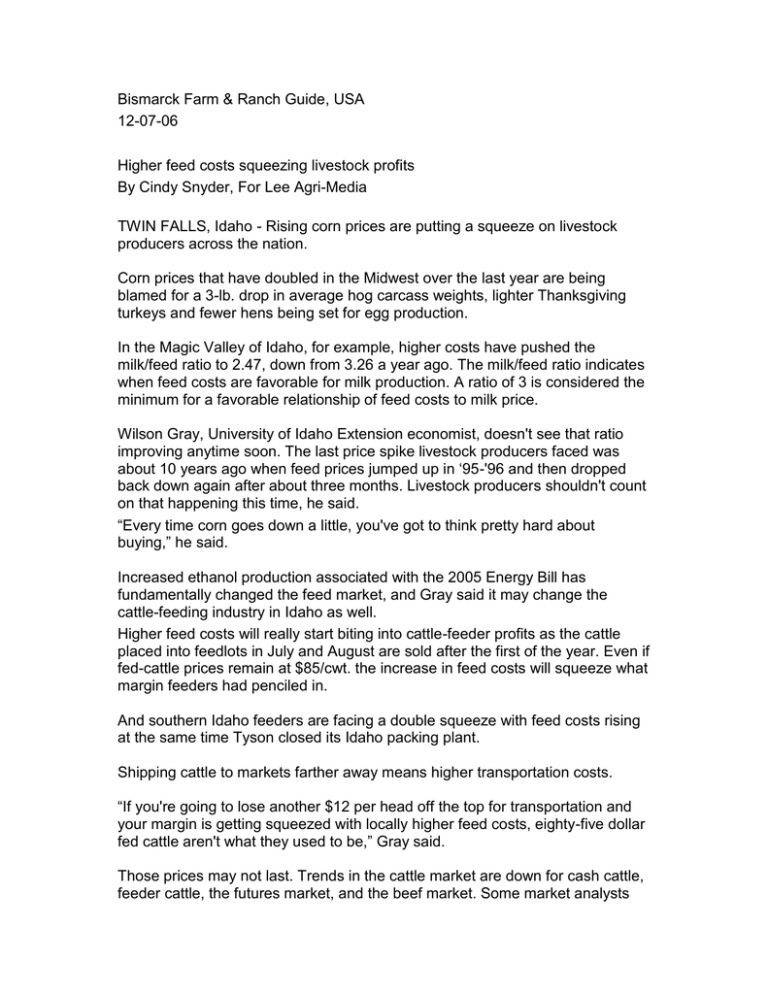
Bismarck Farm & Ranch Guide, USA 12-07-06 Higher feed costs squeezing livestock profits By Cindy Snyder, For Lee Agri-Media TWIN FALLS, Idaho - Rising corn prices are putting a squeeze on livestock producers across the nation. Corn prices that have doubled in the Midwest over the last year are being blamed for a 3-lb. drop in average hog carcass weights, lighter Thanksgiving turkeys and fewer hens being set for egg production. In the Magic Valley of Idaho, for example, higher costs have pushed the milk/feed ratio to 2.47, down from 3.26 a year ago. The milk/feed ratio indicates when feed costs are favorable for milk production. A ratio of 3 is considered the minimum for a favorable relationship of feed costs to milk price. Wilson Gray, University of Idaho Extension economist, doesn't see that ratio improving anytime soon. The last price spike livestock producers faced was about 10 years ago when feed prices jumped up in ‘95-'96 and then dropped back down again after about three months. Livestock producers shouldn't count on that happening this time, he said. “Every time corn goes down a little, you've got to think pretty hard about buying,” he said. Increased ethanol production associated with the 2005 Energy Bill has fundamentally changed the feed market, and Gray said it may change the cattle-feeding industry in Idaho as well. Higher feed costs will really start biting into cattle-feeder profits as the cattle placed into feedlots in July and August are sold after the first of the year. Even if fed-cattle prices remain at $85/cwt. the increase in feed costs will squeeze what margin feeders had penciled in. And southern Idaho feeders are facing a double squeeze with feed costs rising at the same time Tyson closed its Idaho packing plant. Shipping cattle to markets farther away means higher transportation costs. “If you're going to lose another $12 per head off the top for transportation and your margin is getting squeezed with locally higher feed costs, eighty-five dollar fed cattle aren't what they used to be,” Gray said. Those prices may not last. Trends in the cattle market are down for cash cattle, feeder cattle, the futures market, and the beef market. Some market analysts are expecting placements in feedlots to drop for the second month in a row with sharply higher corn prices the reason. On the dairy side, the price outlook is also falling. Analysts had been calling for fairly strong milk prices in 2007, but many abruptly changed their outlook last week with the average milk price for the first half of 2007 falling by 33 cents a cwt. and 25 cents for the last half of the year. That gives an average milk price of $13.99 cwt. for 2007. “Any gains being made in milk price are being offset by higher feed costs,” Gray said. No end in sight - and feed costs are expected to just keep increasing. According to the U.S. Department of Agriculture's November feed report, soybean-meal price for the 2006-2007 marketing year increased by $15 per ton to a midpoint estimate of $177.50 per ton for 48 percent meal, basis Decatur, Ill. USDA forecasters also increased the projected corn price range by 40 cents on either end to $2.80 to $3.20 per bushel with an average price of $3 bu. That compares to $2 bu. a year ago. UI Extension Economist Paul Patterson said he believes USDA may raise the corn price range by 25 to 40 cents per bu. in its December report. Last year, Midwest corn prices were $1.74 bu. at harvest, compared to $3.49 bu. this fall. As ethanol production increases, so will corn price as the market tries to pull additional acres from other crops. Iowa State University's branch of the Food and Agricultural Policy Research Institute released a report last week that predicts more than 15 billion bu. of corn will be grown in 2015 but 11 billion of those bushels will be used for ethanol. FAPRI predicts only 4.6 billion bu. will remain for feed and other industrial usage. The Institute also forecasts that given $60 oil (per barrel), current energy policies and ethanol-plant-operating costs, ethanol plants can pay up to $4.05 per bu. for corn. Livestock producers can use a byproduct of ethanol production distillers grains to try to bring their feed costs down but must be careful. Dairy producers can only substitute distillers grains for about 20 percent of the corn or feed barley in a ration before butterfat and protein start to fall. If producers try to offset 30 percent of their corn or feed barley with distillers grains, overall milk production falls. And feeding large quantities of distillers grains can also affect nutrient management plans for crop acres where manure from the livestock is applied. Research at Iowa State University indicated beef steers fed a ration containing 20 and 40 percent distillers grains excreted 60 and 120 percent more phosphorus in their manure than steers fed a diet containing no distillers grains. “You're still looking at higher feed costs even if you cheapen the ration with some distillers grains,” Gray said. Dried distillers grains ranged from $145 to $176 per ton in Portland in midNovember, up from $117.50 a year ago. Only hay prices appear to be stable, thanks to a good hay crop. “If we see prolonged high feed prices, and milk prices and cattle prices remain where they're at now and don't improve much, we will see some consolidation,” Gray predicted.





